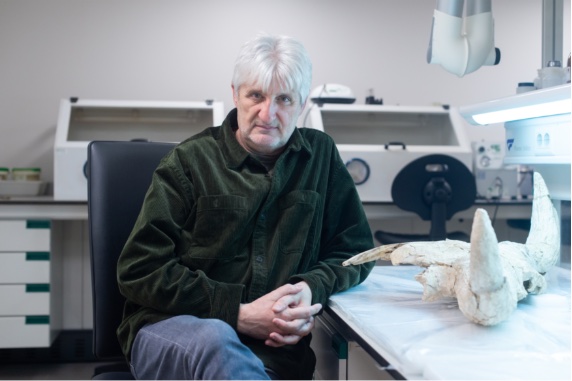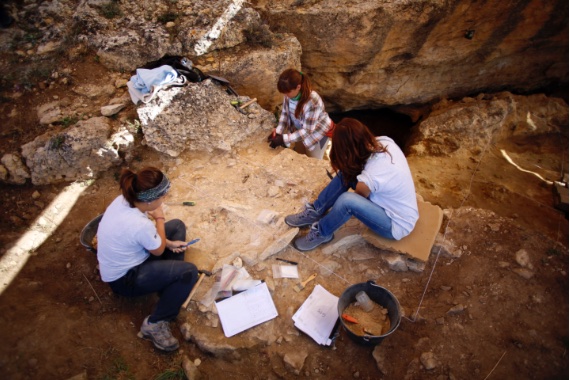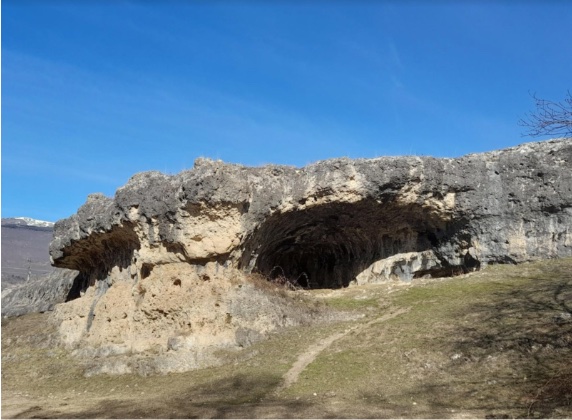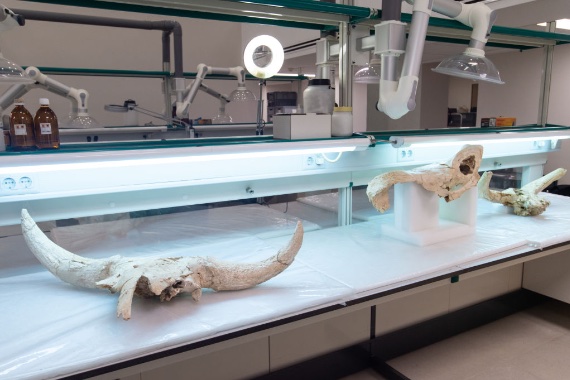Enrique Baquedano (Soria, 1958), director of the Regional Archaeological Museum of the Community of Madrid, knew that he had found confirmation of the hypothesis that Neanderthals had symbolic capacities and exhibited symbolic behaviour when, in 2015, during excavations in the cave known as Cueva Des-Cubierta (central Spain), the team he co-led found a carefully positioned steppe rhinoceros skull resting on some small “clasts” or fragments of rock, just as the inhabitants of Pinilla del Valle (located in the Community of Madrid) had left it more than 40,000 years ago. The rhino skull was given the name Rosendo, in homage to the Spanish rock singer Rosendo Mercado, and belongs to a group of skulls (35 have been recovered) of large ungulates, without teeth, mandibles or maxillae, and all showing signs of manipulation (cut and percussion marks). The findings were recently published in the journal Nature Human Behaviour under the title A symbolic Neanderthal accumulation of large herbivore crania. “It’s a marvellous sanctuary, with the skulls arranged as hunting trophies, we don’t know with what ritual,” Baquedano explains via video call, threading his speech with concise answers and clear explanations, taking extreme care to be precise in his words and displaying a healthy dose of wit.

These skulls show that Neanderthals had symbolic thinking.
It is a deliberate, anthropic and collective behaviour, repeated over time, perhaps over generations. This behaviour is non-utilitarian and non-food related, undoubtedly the result of a belief, a feeling or an idea shared by the group, and it implies the ability to think not only about the basic and elementary, about what is necessary for subsistence of the clan or the daily life of the community, but to go beyond that. It suggests intellectual, cognitive attributes that allowed them to endow objects with concepts, something that is considered human. All this places us in the sphere or terrain of symbolic behaviour, which we can now fully attribute to Neanderthals. We could regard the Nature Human Behaviour paper as the strongest evidence yet for their symbolic capacities.
How does this discovery fit into the simplistic narrative of dumb Neanderthals and smart Cro-Magnons?
To clarify, the archaic Europeans are called sapiens, and the individuals of our species once they arrived in Europe are called Cro-Magnons. In answer to your question, this discovery confirms a line of research and knowledge that the leading scientific community has been working on for about twenty years. In competitive terms, it means that those of us who consider ourselves to be the only sapiens in the world have to share this podium, this pedestal, with a kind of first cousin of ours, who are more brothers than cousins.
In fact, Europeans carry 3% Neanderthal DNA.
Palaeogeneticists have determined that Neanderthals contribute between 2% and 4.5% to the genetics of our species in Eurasian and American populations; sub-Saharan Africans have 0.093% Neanderthal DNA. This means that the sapiens who left Africa acquired Neanderthal genetic material, and a small population of them returned to their continent and mixed with those who had stayed behind.

Has the story of Neanderthals and Cro-Magnons been the story told by the victors for decades?
Yes, this study marks the end of a story of self-congratulation and self-praise.
Juan Luis Arsuaga (co-leader of the research in Cueva Des-Cubierta) said in the newspaper El País that the Neanderthals represent another way of being human, and that is something that we humans today find difficult to imagine.
That comment is the result of many hours together of conversations around the world, from Alaska to Indonesia. What he means is that Neanderthals were just as human as our species at that time.
Two human species with different cultural manifestations, he argues.
I always say, and it is a very striking fact, that the Neanderthals began to bury their dead before our species did. I interpret this as having to do with their environment: Africans did not need to bury because the bodies disappeared within hours, due to predators and the warm environment, whereas the glacial climate in Europe meant that the bodies of loved ones decomposed slowly, and that must have been very sad.
Are we witnessing a kind of vindication of the Neanderthals?
Vindication is not an appropriate term in history, and even less so in archaeology. Our aim is not vindication; we want to know things as they were and put everyone in their rightful place. In science, this vindictive spirit annoys me, Cro-Magnons versus Neanderthals, like the football clubs Madrid versus Barça.

Will we ever know why they became extinct?
If we try to pinpoint a single cause, we’ll never know because they didn’t disappear completely. Some of us think that there was a partial extinction due to a combination of circumstances: infections imported from the south, the sapiens themselves, who were more numerous, more clannish, more technologically advanced and who controlled the hunting grounds, the best valleys and access to drinking water, which may have made it easier to overcome the glacial conditions. As with most extinctions, there is no single motive or reason.
How does an archaeologist feel when he or she is about to make a discovery of the importance of Cueva Des-Cubierta?
I am currently writing a book for Penguin Random House entitled Stories of a Very Lucky Archaeologist. Louis Leakey, the discoverer of the first hominid remains of the genus Homo, said that luck is important in palaeontological research. My colleague Alfredo [Pérez-González, geologist and third co-leader of the research] says no, that it is pure wisdom [laughs]. In this case, I think it is the result of both.
And perseverance.
We have been working on these sites since 2002. In 2006, we discovered the Cueva de la Buena Pinta, with fossils from the Middle Pleistocene. In 2007 and 2008, we carried out geophysical surveys, which didn’t find a cave in an area where I thought there would be one. In the spring of 2009, we located Cueva Des-Cubierta. In the following years, we discovered hunting trophies associated with small hearths, which could be related to some kind of ritual. We confirmed this in 2015, presented it at a conference in 2016, and have just published it in 2023.
Is it normal for so much time to elapse between discovery and publication?
When the discovery is made by young people, it goes faster, for curricular reasons. But we three co-leaders are at the zenith of our careers, so we could afford the luxury of not publishing until we had everything perfectly in order.

What has the reception to the publication been like?
I’m a bit annoyed because it’s been too well received. I expected controversy [laughs]. There has been little debate.
And now what?
This first paper will be the key to many others, partial publications that we are already preparing, on fossils, the lithic industry, the study of herbivores, the evolution of the speleogenesis [the creation and destruction of the cave, he explains]. There is still a lot of work ahead.
Have you always been interested in Neanderthals?
I finished my degree in 1980, at the Complutense University of Madrid, and back then I found them boring. I wasn’t a great believer in Neanderthals having enormous intellectual capacities until I saw their first remarkable accumulation, in the summer campaign of 2009.
Comments on this publication